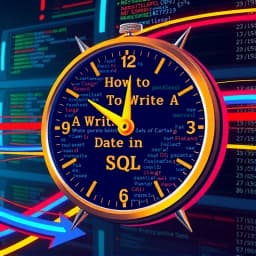
How to Write a Date in SQL
Find this useful? Bookmark ( CTRL/CMD + D ) for quick access!
Try an example:
Insert Date Records
Format Date Queries
Update Date Fields
Filter By Date
Convert Date Formats
Calculate Date Differences
Explore Similar Tools
Recent Generations
the amount paid directly to you. Yes it is possible in future cases to request direct payment to the provider, Rephrase and give me polished email.
we have processed the claim as per the attachments in the claim submission we have processedthe invoice for Saul Holding. We dont have invoice for the Salofalk.
this additional information is very important. this adiitional information was requested by our clinical team. Without clinical review claim not be paid so please share the below additional information
How To Write A Date In SQL is a comprehensive AI-powered guide designed to assist users in mastering date formatting and manipulation within SQL databases. This tool simplifies the complexities of SQL date functions, enabling users to efficiently handle date-related queries and operations.
Key Capabilities
- Date Formatting: Easily format dates in various styles to meet specific database requirements, ensuring consistency and accuracy in your SQL queries.
- Date Arithmetic: Perform calculations with dates, such as adding or subtracting days, months, or years, to streamline data analysis and reporting.
- Error Handling: Identify and troubleshoot common date-related errors in SQL, helping users avoid pitfalls and improve query performance.
- Comprehensive Examples: Access a wide range of practical examples and templates for writing date queries, making it easier to learn and implement SQL date functions.
Who It's For
Designed for database administrators, data analysts, and developers, How To Write A Date In SQL excels in enhancing SQL proficiency. Whether you're creating reports, managing data entries, or optimizing database queries, this tool streamlines your workflow and boosts productivity.
Why Choose How To Write A Date In SQL
What sets How To Write A Date In SQL apart is its user-friendly interface and extensive library of resources, making it the ideal solution for anyone looking to improve their SQL date handling skills.
Ready to transform your SQL date management? Start using How To Write A Date In SQL today and experience the difference in your database operations!
Enhance Your Work with How to Write a Date in SQL
Leverage the power of AI to streamline your tasks with our How to Write a Date in SQL tool.
Date Formatting Guidance
Receive step-by-step instructions on how to format dates correctly in SQL for various database systems.
Syntax Examples
Access a library of syntax examples for writing date queries, including comparisons and functions.
Troubleshooting Support
Get assistance with common date-related errors in SQL, ensuring your queries run smoothly.
How How to Write a Date in SQL Works
Discover the simple process of using How to Write a Date in SQL to improve your workflow:
Select Date Format
Choose the desired date format for your SQL query, such as 'YYYY-MM-DD' or 'MM/DD/YYYY'.
Input Your Date
Enter the date you want to format into the tool, ensuring it matches the selected format.
Generate SQL Query
Click the generate button to create the SQL query that includes your formatted date.
Copy and Use
Copy the generated SQL query and use it in your database operations as needed.
Use Cases of
How to Write a Date in SQL
Explore the various applications of How to Write a Date in SQL in different scenarios:
Data Retrieval
Learn how to format and write dates in SQL queries to accurately retrieve records based on date criteria.
Database Management
Understand the correct syntax for inserting, updating, and deleting date fields in SQL databases.
Reporting and Analytics
Generate reports that require date filtering, grouping, and sorting to analyze trends over time.
Application Development
Integrate date handling in SQL for web and mobile applications to ensure proper data handling and user interactions.
Who Benefits from How to Write a Date in SQL?
AI-Powered Efficiency
From individuals to large organizations, see who can leverage How to Write a Date in SQL for improved productivity:
Database Administrators
Efficiently manage and manipulate date data within SQL databases.
Data Analysts
Analyze time-series data and perform date-based queries with ease.
Software Developers
Integrate date handling in applications to enhance functionality and user experience.
Business Intelligence Professionals
Visualize and report on date-related metrics for better business insights.
Frequently Asked Questions
What formats can I use to write dates in SQL?
In SQL, you can write dates in various formats, such as 'YYYY-MM-DD', 'MM/DD/YYYY', or 'DD-MON-YYYY'. The specific format may depend on the SQL dialect you are using.
How do I insert a date into a SQL database?
To insert a date into a SQL database, you can use the INSERT statement. For example: INSERT INTO table_name (date_column) VALUES ('YYYY-MM-DD'); Make sure to use the correct date format for your SQL dialect.
Can I perform date calculations in SQL?
Yes, SQL allows you to perform various date calculations, such as adding or subtracting days, months, or years using functions like DATEADD, DATEDIFF, and others depending on the SQL dialect.
What should I do if my date format is incorrect?
If your date format is incorrect, you can use the CONVERT or CAST functions to change the format before inserting or querying the date. Always ensure that the format matches the expected format of your SQL database.
Are there any best practices for handling dates in SQL?
Yes, best practices include using the ISO 8601 format ('YYYY-MM-DD') for dates, avoiding string representations of dates, and utilizing date functions for comparisons and calculations to ensure accuracy and consistency.
































